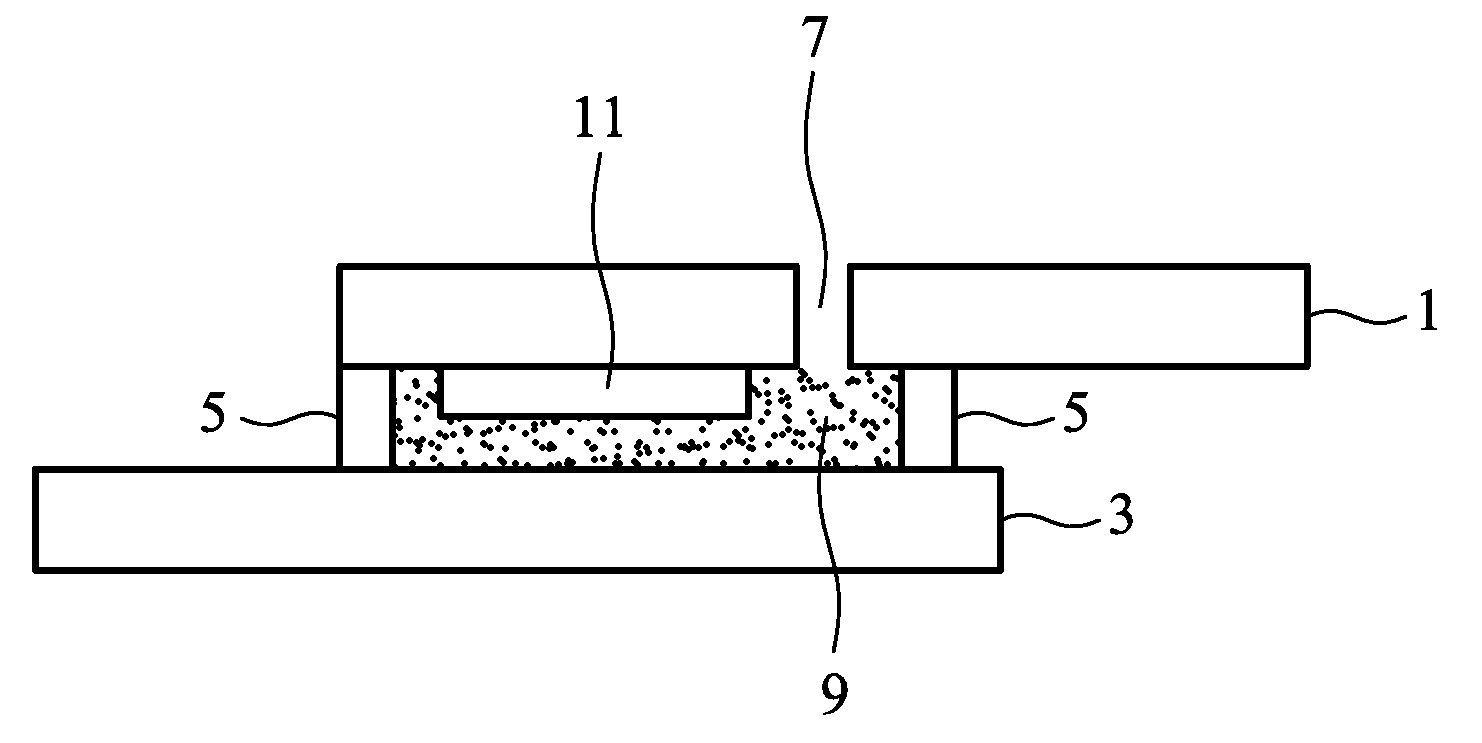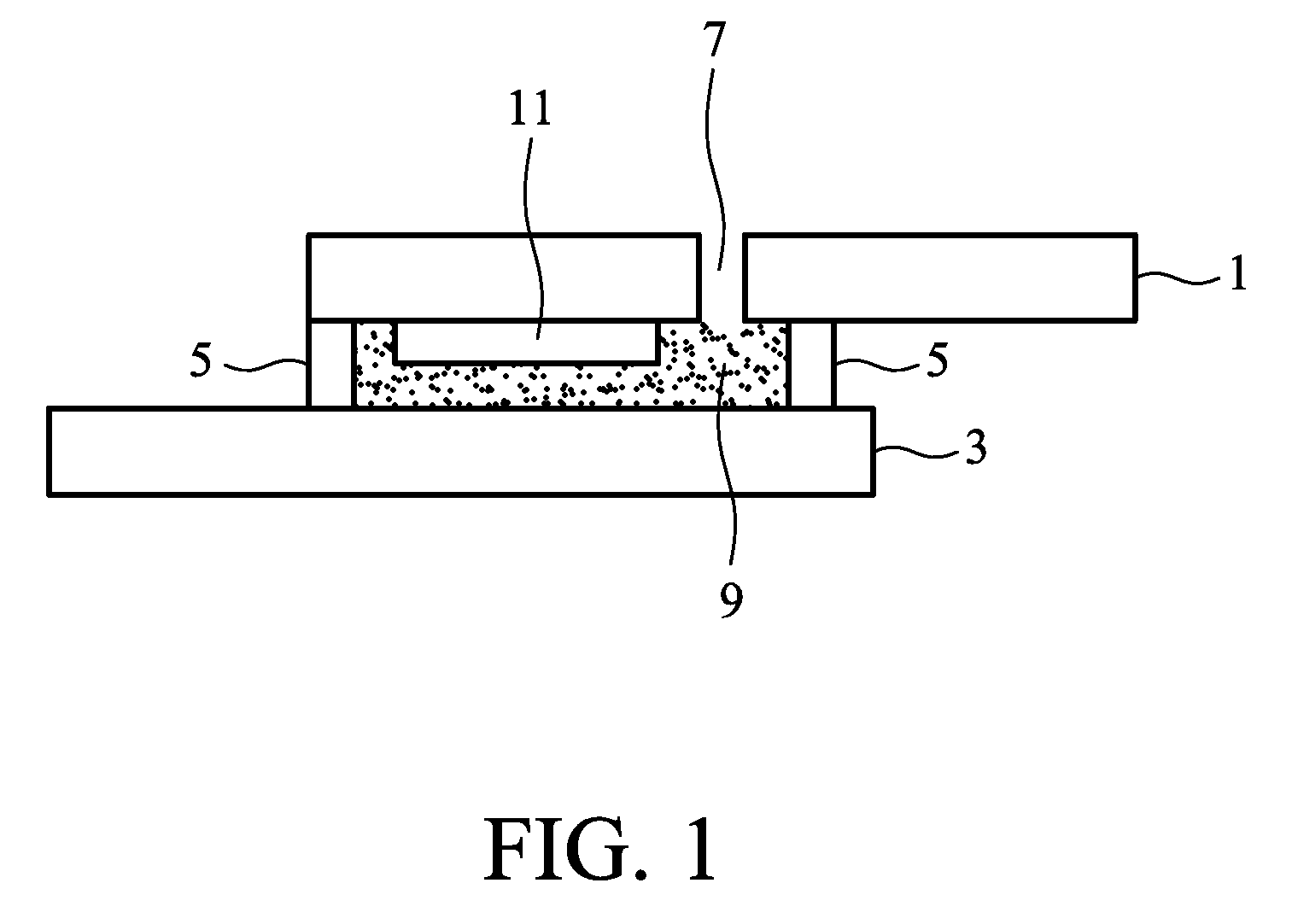Gel electrolyte of dye sensitized solar cell and method for manufacturing the same
a solar cell and dye sensitization technology, applied in the field of gel electrolyte, can solve problems such as reducing device performan
- Summary
- Abstract
- Description
- Claims
- Application Information
AI Technical Summary
Benefits of technology
Problems solved by technology
Method used
Image
Examples
example 1
[0035]10 g of N,N′-bismaleimide-4,4′-diphenylmethane was dissolved in the co-solvent of 23.57 mL of N-methyl-2-pyrrolidone and 23.57 mL of propylene carbonate, was then added 1.7869 g of barbituric acid, heated to 130° C. to react for 5 hours, and then cooled at room temperature to form a hyper-branched bismaleimide oligomer serving as gelling additive. Subsequently, an ionic liquid electrolyte including 0.6M 1-methyl-3-propylimidazolium iodide, 0.1M lithium iodide, 0.05M iodine, and 0.5M 4-tert-butylpyridine was prepared. 0.0986 g of the gelling additive, 0.22 g of the ionic liquid electrolyte, and 0.7466 g of acetonitrile were evenly mixed. The mixture was injected into the space between the top and bottom substrates, and the device was then sealed. The mixture was left at room temperature for a period of time to form the gel electrolyte, thereby completing the dye sensitized solar cell. Exposed to light of 100 mW / cm2, the current density versus voltage curves of the solar cell ar...
example 2
[0036]10 g of N,N′-bismaleimide-4,4′-diphenylmethane was dissolved in the co-solvent of 23.57 mL of N-methyl-2-pyrrolidone and 23.57 mL of propylene carbonate, then added 1.7869 g of barbituric acid, heated to 130° C. to react for 5 hours, and then cooled to room temperature to form a hyper-branched bismaleimide oligomer serving as gelling additive. Subsequently, an ionic liquid electrolyte including 0.6M 1-methyl-3-propylimidazolium iodide, 0.1M lithium iodide, 0.05M iodine, and 0.5M 4-tert-butylpyridine was prepared. 0.0986 g of the gelling additive, 0.22 g of the ionic liquid electrolyte, and 0.5888 g of propylene carbonate were evenly mixed. The mixture was injected into the space between the top and bottom substrates, and the device was then sealed. The mixture was left at room temperature for a period of time to form the gel electrolyte, thereby completing the dye sensitized solar cell. Exposed to light of 100 mW / cm2, the current density versus voltage curves of the solar cell...
example 3
[0037]10 g of N,N′-bismaleimide-4,4′-diphenylmethane was dissolved in the co-solvent of 23.57 mL of N-methyl-2-pyrrolidone and 23.57 mL of propylene carbonate, then added 1.7869 g of barbituric acid, heated to 130° C. to react for 5 hours, and then cooled to room temperature to form a hyper-branched bismaleimide oligomer serving as gelling additive. Subsequently, an ionic liquid electrolyte including 0.6M 1-methyl-3-propylimidazolium iodide, 0.1M lithium iodide, 0.05M iodine, and 0.5M 4-tert-butylpyridine was prepared. 0.0986 g of the gelling additive, 0.22 g of the ionic liquid electrolyte, 0.2944 g of propylene carbonate, and 0.3733 g of acetonitrile were evenly mixed. The mixture was injected into the space between the top and bottom substrates, and the device was then sealed. The mixture was left at room temperature for a period of time to form the gel electrolyte, thereby completing the dye sensitized solar cell. Exposed to light of 100 mW / cm2, the current density versus voltag...
PUM
| Property | Measurement | Unit |
|---|---|---|
| diameter | aaaaa | aaaaa |
| temperature | aaaaa | aaaaa |
| VOC | aaaaa | aaaaa |
Abstract
Description
Claims
Application Information
 Login to View More
Login to View More - R&D
- Intellectual Property
- Life Sciences
- Materials
- Tech Scout
- Unparalleled Data Quality
- Higher Quality Content
- 60% Fewer Hallucinations
Browse by: Latest US Patents, China's latest patents, Technical Efficacy Thesaurus, Application Domain, Technology Topic, Popular Technical Reports.
© 2025 PatSnap. All rights reserved.Legal|Privacy policy|Modern Slavery Act Transparency Statement|Sitemap|About US| Contact US: help@patsnap.com



